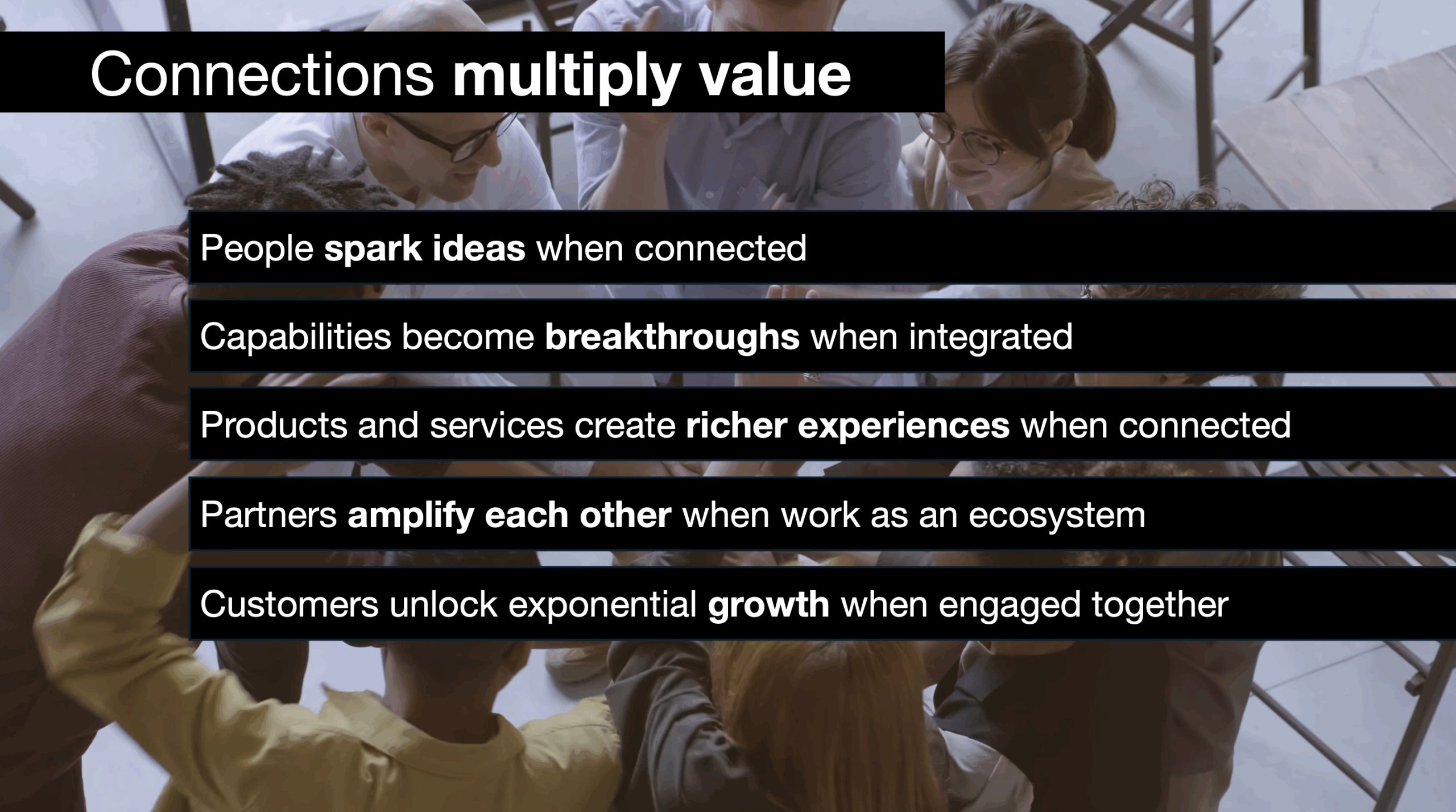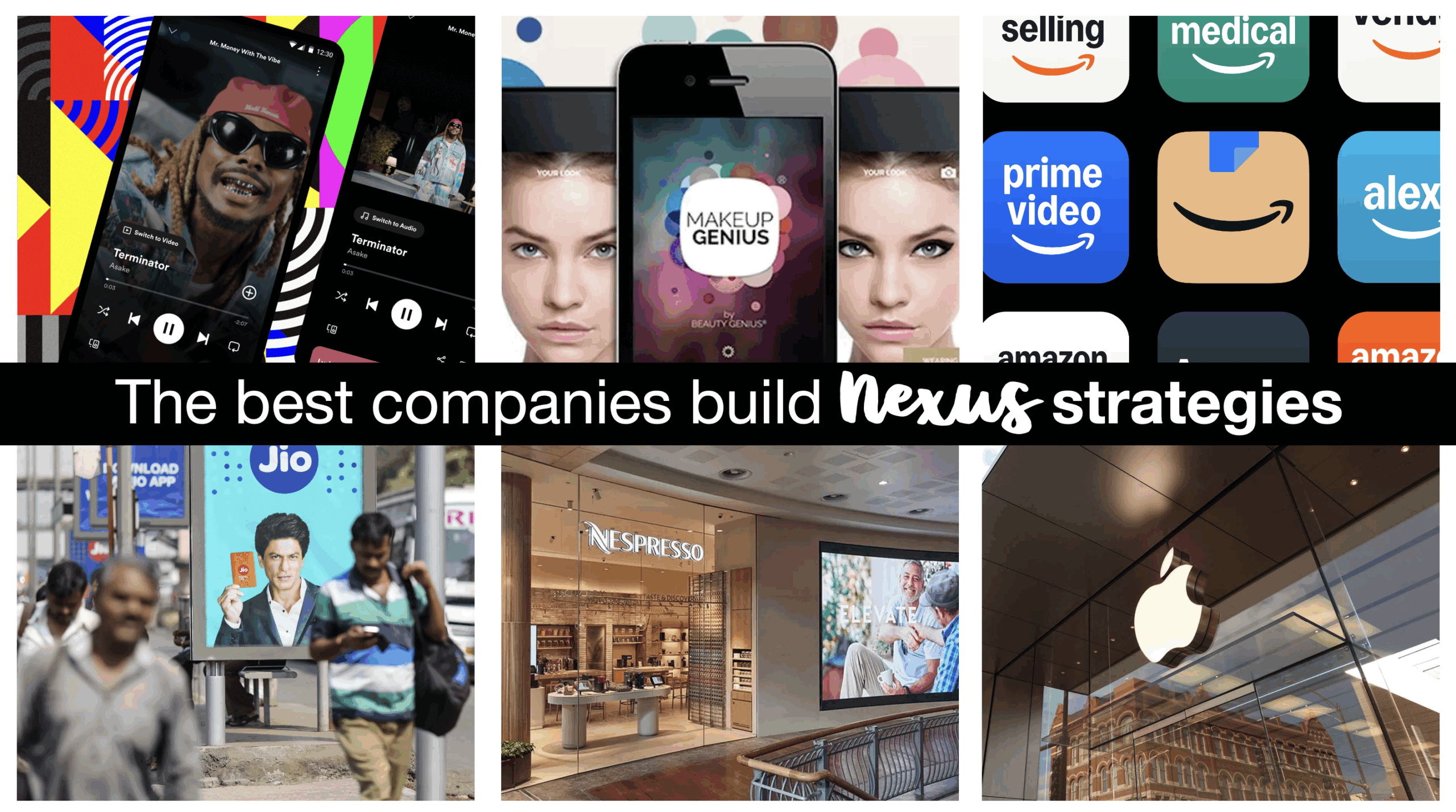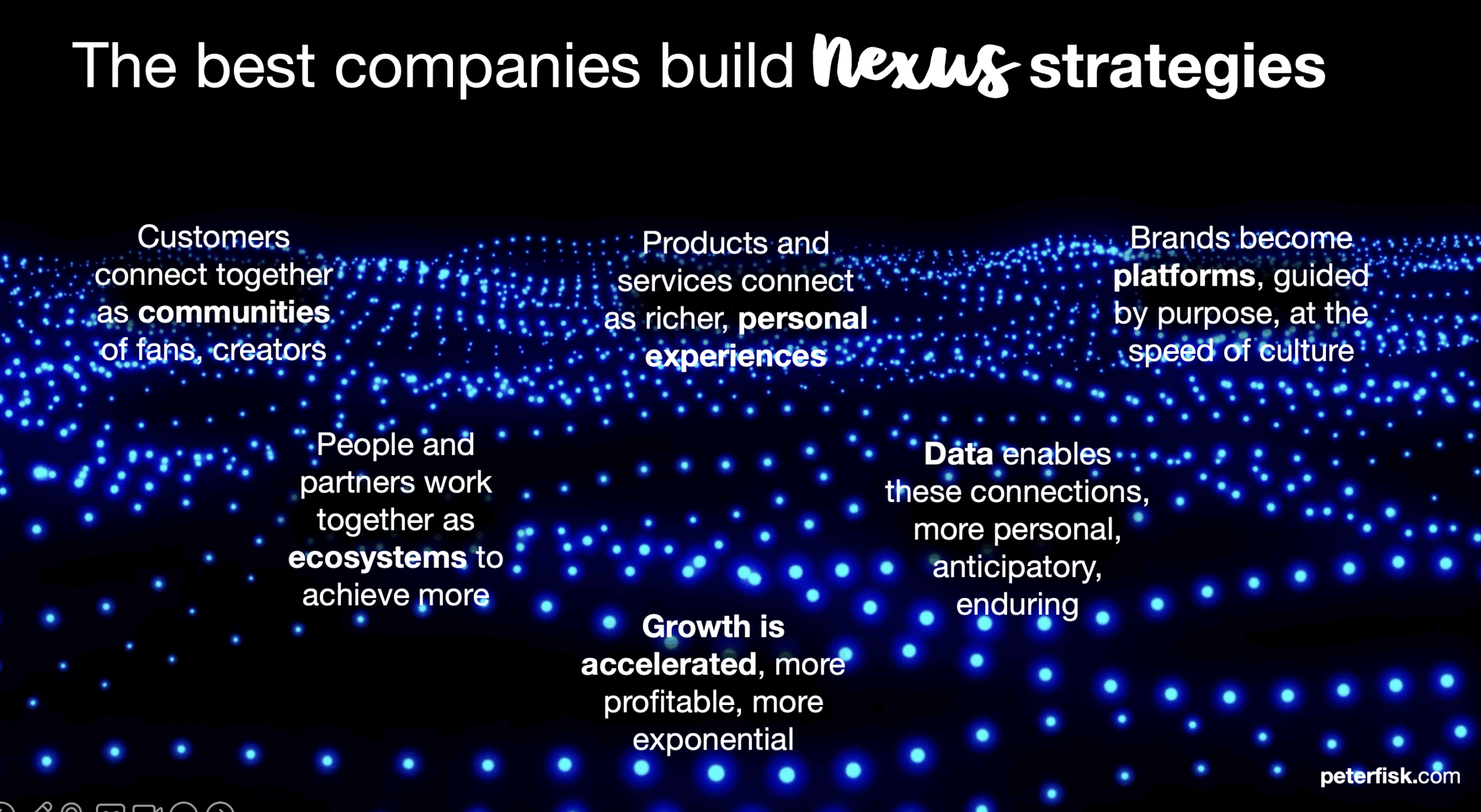The Nexus Effect: Unlocking the Power of Connections
October 1, 2025 at Barcelona

Business has always been about relationships. From the earliest merchants in Mesopotamian markets to the industrial giants of the twentieth century, success was determined by who could connect supply and demand most effectively. Yet in today’s hyper-networked, digital-first world, connections matter in ways that are far more complex, pervasive, and valuable than ever before.
The twenty-first century economy is no longer defined by the simple transaction of product for price, but by ecosystems of value, experiences, and services that bind customers and companies together in ongoing relationships. The companies that thrive are those that don’t merely sell things, but create webs of connection — to customers, between products, across services, and through communities.
The Nexus Effect
This is the essence of the Nexus Effect. A nexus is a focal point, a hub, or a set of connections that give meaning and power. In business, the nexus represents how companies integrate multiple touchpoints, technologies, and experiences to form a network that is greater than the sum of its parts. It is about creating systems in which customers are not one-time buyers but ongoing participants — members, subscribers, creators, fans, or even co-owners of the brand journey.
The most successful businesses today understand that value creation no longer ends at the point of purchase. Instead, it extends across the entire lifecycle — from discovery and engagement to usage, renewal, and advocacy. Every touchpoint strengthens the connection; every service deepens loyalty; every interaction reinforces the brand. In this world, customer relationships are no longer linear, but circular and exponential.
Eight global companies exemplify this phenomenon in unique and powerful ways: Amazon, Nespresso, L’Oréal, Disney, Spotify, Jio, and Apple. Each has built its own nexus of connections — spanning subscriptions, memberships, communities, services, and ecosystems — that transform customers from passive consumers into active participants. Each case shows how connections drive more than loyalty: they drive scale, innovation, resilience, and enduring growth.
We explore these stories in depth, before drawing out the patterns of nexus strategies and what they mean for leaders determined to succeed in a connected age.

Unlocking the Power of Connections
The Nexus Effect is not a new phenomenon, but it is more powerful today because of technological, social, and cultural shifts.
-
Digital platforms make it easier than ever to connect customers continuously.
-
Data and AI allow personalization at scale, turning relationships into uniquely tailored experiences.
-
Communities thrive online, creating spaces where customers connect not just with brands, but with each other.
-
Subscriptions and memberships create predictable revenue streams while binding customers into ongoing usage loops.
-
Ecosystems amplify value by linking products and services, making it harder for customers to leave without losing convenience or benefits.
In essence, companies no longer compete simply as product providers but as architects of networks of value. The winners are those who can connect the dots between customers’ needs, aspirations, and lifestyles — and deliver continuously through a nexus of products, services, and experiences.

Let’s explore how these companies have unlocked the potential of connections.
Amazon … The Nexus of Retail
Amazon began in 1994 as an online bookstore. Its founder, Jeff Bezos, envisioned an “everything store” that could harness the internet’s limitless reach. What has made Amazon extraordinary, however, is not just scale, but its ability to build an ecosystem where connections multiply value.
At the heart of this ecosystem is Amazon Prime. Launched in 2005 as a free-shipping program, Prime has evolved into one of the most powerful membership platforms in the world. With more than 250 million global subscribers by 2025, Prime generates loyalty not because customers love paying annual fees, but because it integrates multiple forms of value:
-
Convenience: Unlimited fast shipping.
-
Entertainment: Prime Video, Prime Music, Prime Gaming.
-
Savings: Exclusive deals and discounts.
-
Everyday living: Grocery delivery (Whole Foods, Amazon Fresh), photo storage, audiobooks.
Prime exemplifies the Nexus Effect: every additional service makes the membership more “sticky,” increasing customer reliance. Prime members spend on average more than twice as much per year as non-members, and churn is astonishingly low.
Amazon’s ecosystem extends further. Alexa connects homes to shopping, entertainment, and smart devices. AWSconnects businesses to computing power and digital innovation. Marketplace connects millions of third-party sellers to global customers, while Amazon logistics links the entire supply chain. Each reinforces the other — a flywheel of connection that accelerates growth.
What makes Amazon unique is not simply breadth, but the way these services reinforce each other in the customer’s daily life. Customers don’t just shop at Amazon; they live within its ecosystem.
Nespresso … The Nexus of Coffee
When Nestlé launched Nespresso in 1986, it was a slow burn. The single-serve capsule coffee system seemed niche, even indulgent. But over time, Nespresso reinvented the coffee experience by building not just a product, but a lifestyle community.
The Nespresso Club has been central to this strategy. Customers who buy a machine are invited to join, gaining access to exclusive capsules, services, and experiences. The Club is not a traditional loyalty program; it is a membership ecosystem.
-
Direct-to-consumer channels: Nespresso pioneered selling capsules directly to members via boutiques, online platforms, and dedicated call centers.
-
Personalization: Members are offered curated selections, seasonal flavors, and limited editions.
-
Sustainability and responsibility: Capsule recycling programs invite members to participate in a shared mission.
-
Lifestyle branding: Partnerships with George Clooney and luxury positioning elevate the product beyond commodity.
By controlling the entire lifecycle — from machine to capsule to membership — Nespresso ensures recurring revenue and strong lock-in. The Club transforms coffee from a product into a relationship of rituals, identity, and belonging.
Today, Nespresso serves millions of members worldwide, with annual revenues exceeding $6 billion. Its success lies not in selling coffee pods, but in making customers feel like insiders in an exclusive global community.
L’Oréal … The Nexus of Beauty
Beauty is one of the most emotional and intimate industries, and L’Oréal has become the world’s largest cosmetics company by combining science, creativity, and connection. Its mission is simple yet powerful: “Beauty for all.”
In recent years, L’Oréal has embraced beauty tech as a way of deepening customer relationships. This includes:
-
Makeup Genius: An augmented reality app launched in 2014 that lets customers virtually try on products. It was downloaded millions of times and paved the way for AI-driven personalization.
-
ModiFace (acquired in 2018): Provides AR try-ons across L’Oréal brands, integrated directly into e-commerce.
-
Skin and hair diagnostics: AI-powered tools that recommend personalized regimes.
-
Communities: Platforms where beauty enthusiasts share tips, routines, and looks, reinforcing brand bonds.
L’Oréal doesn’t just sell lipstick or skincare; it connects customers with solutions that feel uniquely theirs. Every digital tool deepens engagement and makes switching less likely. Moreover, the company’s sustainability commitments (like refillable packaging and carbon-neutral operations) create an additional emotional nexus around shared values.
The result: L’Oréal connects across science, technology, and lifestyle, making customers participants in beauty innovation rather than passive buyers.
Disney … The Nexus of Magic
Few companies understand connection better than Disney. For nearly a century, Disney has built emotional bonds with audiences through storytelling. What makes Disney extraordinary today is how it weaves these stories into an integrated nexus of experiences.
-
Disney+: With over 200 million subscribers by 2025, Disney+ is the beating heart of its digital ecosystem. It doesn’t just stream content; it immerses fans in story worlds (Marvel, Star Wars, Pixar).
-
Parks and resorts: Physical spaces where fans live the stories they love, connected seamlessly to films and merchandise.
-
Merchandising and licensing: Extending characters into toys, clothing, and everyday life.
-
Community and fandom: Fans connect not only with Disney but with each other, from conventions to online forums.
Disney creates a virtuous cycle of connection: watch a Marvel movie, subscribe to Disney+, visit Avengers Campus at Disneyland, buy the merchandise, and discuss theories with fellow fans online. Each element reinforces the others, creating lifetime value that far exceeds a ticket price or subscription fee.
The nexus is emotional as much as commercial: Disney is not just entertainment but identity, nostalgia, and belonging. Customers don’t simply consume; they live inside Disney’s stories.
Jio … The Nexus of India
When Reliance Industries launched Jio in 2016, it disrupted India’s telecom market with ultra-cheap data and free voice calls. Within a few years, Jio amassed over 450 million subscribers, transforming connectivity in one of the world’s largest markets.
But Jio’s ambition went far beyond telecom. It has built a super app ecosystem that connects users to multiple aspects of life:
-
JioMart: Groceries and retail.
-
JioSaavn: Music streaming.
-
JioCinema: Entertainment.
-
JioMoney: Digital payments and financial services.
-
JioSecurity and JioCloud: Data and device protection.
In essence, Jio is creating an Indian equivalent of WeChat — an integrated platform where customers handle communication, shopping, entertainment, and finance.
By bundling services at low cost, Jio locks users into its ecosystem while bringing millions of first-time digital customers online. Its nexus strategy is not only commercial but national: Jio is shaping India’s digital future by connecting people, communities, and commerce at scale.
Spotify … The Nexus of Music
Music has always been social, but Spotify turned listening into a global, personalized community. Launched in 2008, Spotify pioneered streaming subscriptions and today has over 600 million users (more than 250 million paying subscribers).
Its nexus strategy rests on three pillars:
- Personalization: Playlists like Discover Weekly and Release Radar feel tailor-made. Algorithms connect users with music they didn’t know they needed.
- Community: Playlists are shareable, collaborative, and social. Fans follow artists and each other, building networks of taste.
- Creator connection: Through tools like Spotify for Artists and podcasting platforms, creators connect directly with fans.
Spotify Premium provides ad-free listening, downloads, and higher quality, while the free tier keeps the funnel wide. Beyond music, Spotify has expanded into podcasts and audiobooks, broadening its ecosystem.
Spotify’s true genius is that customers don’t feel like subscribers to a utility; they feel like members of a global music community. Music becomes not just consumed but shared, discovered, and lived through the platform.
Apple … The Nexus of Desire
If there is one company that epitomizes the Nexus Effect, it is Apple. With more than 1.5 billion active devicesworldwide, Apple has created the most valuable ecosystem in consumer technology.
Its nexus is built on four layers of connection:
-
Hardware: iPhone, iPad, Mac, Apple Watch, AirPods — beautifully designed, seamlessly integrated.
-
Software and services: iOS, iCloud, App Store, Apple Music, Apple TV+, Apple Arcade.
-
Membership and subscriptions: iCloud+, Apple One bundles, fitness subscriptions.
-
Community and lifestyle: Apple Stores, developer conferences, loyal fan culture.
Apple devices are designed to work best with each other, creating a walled garden that keeps customers inside. Switching out of the Apple ecosystem means losing convenience, integration, and emotional resonance.
Customers often own multiple Apple devices — with the average user connected to 2–3 products. This multiplies lifetime value, while services generate recurring revenues. In 2023, Apple’s services business alone surpassed $85 billion annually.
The magic lies not just in lock-in, but in emotional connection. Apple represents simplicity, creativity, and status. Customers feel not just like buyers but members of a global community united by design and innovation.

Patterns of Nexus Strategies
Across these cases, common patterns emerge:
-
Membership at the core: Prime, Nespresso Club, Disney+, Spotify Premium, Apple One — all create predictable, ongoing engagement.
-
Ecosystem lock-in: Multiple products and services work better together (Amazon, Apple, Jio).
-
Emotional connection: Disney stories, Apple design, L’Oréal beauty personalization.
-
Communities of participation: Spotify playlists, Nespresso sustainability efforts, IBM co-creation, Disney fandom.
-
Lifecycle ownership: From discovery to renewal, companies manage the entire journey (Nespresso, Apple, Amazon).
-
Values-driven connection: Sustainability (L’Oréal, Nespresso), trust (IBM), empowerment (Spotify).
The Nexus Effect is not one model but a set of strategies that together deepen customer ties and amplify value.
Implications for Leaders
For today’s business leaders, the lesson is clear: connection is strategy. To harness the Nexus Effect, leaders must:
-
Think in systems, not silos — Design offerings that interconnect, creating value loops rather than linear funnels.
-
Prioritize memberships and services — Shift from transactions to recurring models that reinforce loyalty.
-
Leverage data responsibly — Use personalization to create intimacy without eroding trust.
-
Foster communities — Enable customers to connect with each other, not just with the brand.
-
Align with values — Build emotional as well as functional bonds.
-
Design for lifetime value — Look beyond the first sale to the entire customer journey.
Leaders must recognize that customers today don’t just buy products; they buy into relationships, identities, and ecosystems. The companies that succeed are those that turn connections into compounding advantage.
The Best Companies are Nexus Companies
The Nexus Effect will only grow in power as technologies evolve and societies become more connected. Artificial intelligence will deepen personalization; augmented and virtual reality will expand immersion; blockchain and Web3 may redefine ownership and membership.
But at its heart, the Nexus Effect is timeless. It is about human connection — the need for belonging, convenience, trust, and shared meaning. The companies that master this will not just sell more, but will create enduring bonds with customers who become participants, advocates, and co-creators.
From Amazon’s Prime flywheel to Apple’s walled garden, from Disney’s story worlds to Jio’s national super app, the lesson is clear: connections are the new currency of business. Those who can unlock their power will define the future.
What’s your nexus?